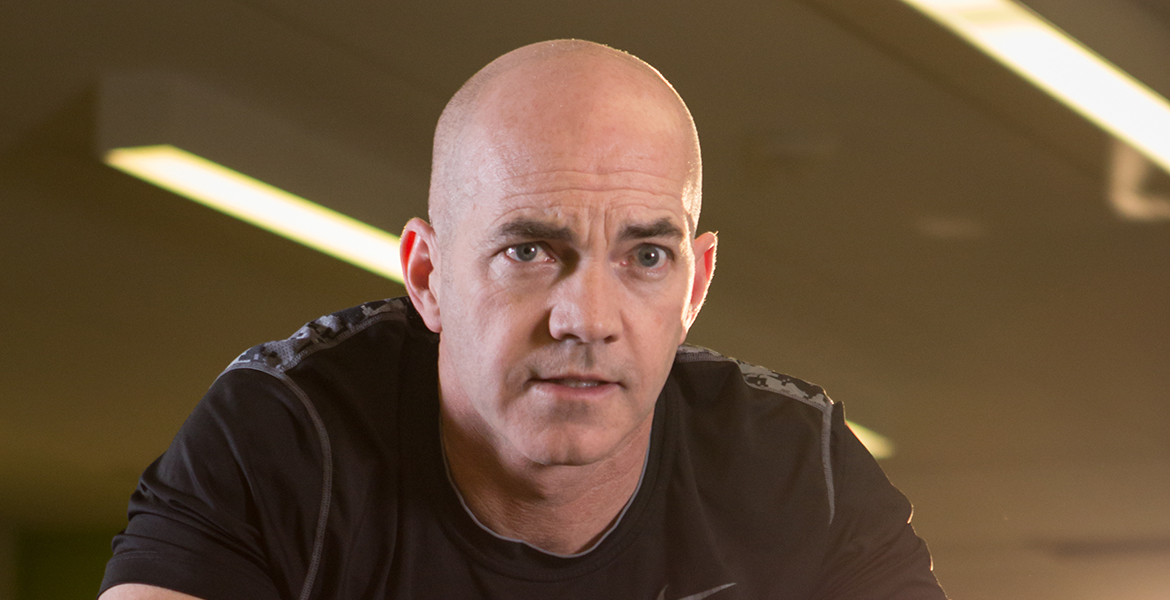
Exercise has been proven to boost fat-burning metabolism, slow bone loss, help treat and prevent depression, and decrease risk of heart disease and cancer.
Why don’t we want to do it?
Not enough time is the number one reason cited by people, says Martin Gibala BHK ’91.
But what if you could become more fit in less time? That’s the theory behind “interval training”, the subject of his book, The One-Minute Workout: Science Shows a Way to Get Fit That’s Smarter, Faster, Shorter.
The 2017 book attracted global media attention from such outlets as The New York Times, CNN, NBC Nightly News, the Today Show, and Time Magazine. Gibala, who has published more than 100 scholarly journal articles on interval training, collaborated with author Christopher Shulgan.
Interval training is any activity that involves alternating periods of more intense effort and recovery, explains the researcher. “The idea is to vary the intensity of your workout. Go hard, relax, and repeat.”*
Interval training is not new, says Gibala, chair of the Department of Kinesiology at McMaster University in Hamilton, Ont. “It dates to the early 20th century, when Finnish athletes won Olympic gold training almost exclusively with intervals.”
The book was the result of a series of research studies that asked the question: how low can you go? The answer is based on the most intense version tested in Gibala’s studies:
• Two-minute warm-up
• 20 seconds of intense exercise
• Two-minute recovery (lower intensity or complete rest)
• 20 seconds of intense exercise
• Two-minute recovery
• 20 seconds of intense exercise
• Three-minute cool down
So, “The One-Minute Workout” actually takes 10 minutes. The most important thing is, “to just get out of your comfort zone. Push a bit and then recover.”
Intervals can be applied to any kind of exercise, he says. “Walking, running, swimming, hiking. Anything.”
Born in Windsor, the alumnus originally intended to study architecture but switched to kinesiology. He found his calling in second year when he took a physiology course, where he learned how the body functions.
Gibala, who participated in triathlons at that time, appreciated the ability to understand the body based on its physiology systems and limits, and structure his training accordingly.
After completing postdoctoral studies at the world-renowned Copenhagen Muscle and Research Centre, he eventually taught full time at McMaster. He’s received three awards for teaching excellence at McMaster as well as the President’s Award for Excellence in Graduate Student Supervision.
In 2005, his lab published a study that made headlines around the world. It showed that short bouts of intense exercise could lead to profound benefits in just two weeks.
A more recent study directly compared The One Minute Workout with public health guidelines that generally call for 150 minutes per week of moderate exercise.
Participants in one group completed three 20-second intervals on a stationary bicycle, pedaling as hard as they could, with two minutes of gentle, slow pedaling between each interval. The other group cycled continuously at a moderate pace for 50 minutes each session.
After 12 weeks of training, three times per week, the results were remarkably similar. Both groups were more aerobically fit and improved their blood sugar control, despite a five-fold difference in exercise time commitment.
Interval training can be adjusted to almost any level of fitness.* “It’s not just for elite athletes,” says Gibala. “Even interval walking has been shown to be more effective than moderate, continuous walking to boost fitness in people with diabetes.”
“The number one goal is to be fit. That’s more important than chasing an unrealistic body weight ideal.”
*It is advisable not to start any exercise routine without consulting your physician.
Find out more at www.martingibala.com